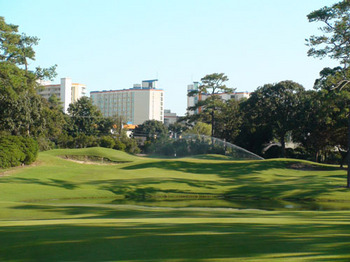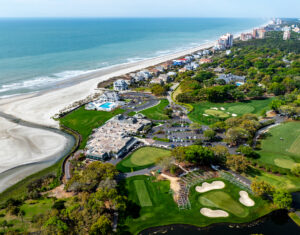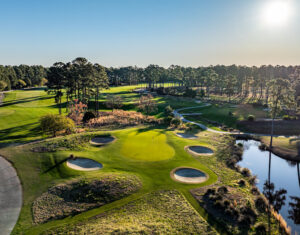Hole-By-Hole Guide To The New Pine Lakes
 Pine Lakes Country Club Hole-By-Hole Guide
Pine Lakes Country Club Hole-By-Hole Guide
Hole No. 1 Par 4, 346 yards
— Formerly hole No. 10
— Pine Lakes opens with three shorter and straight holes purposely designed by Craig Schreiner to build the golfers’ confidence at the beginning of the round
— “Risk and reward” hole as low handicappers can choose to hit over two prominent bunkers that guard the green in the front while high handicappers can choose safer elevated grass approach on the right side
— One of the largest greens on the course
— Tee boxes were shifted north
— Pond was enlarged
— Existing bunkers were enlarged and lowered with carom feature added to develop alternate route to green
Hole No. 2 Par 3, 193 yards
— Formerly hole No. 11
— Golfers tee off into the wind and negotiate an enlarged water hazard to reach the green
— Bunkers flank both sides of the green with a natural area located behind the green
— Approach was shifted and raised to offset deeper bunkers
— Large mound was added to separate the hole from No. 1
— Tree corridors were kept intact from the old routing
— Tee boxes were relocated to the left
— Green was enlarged and raised two feet
— Pond was expanded and lowered in front of green
— Natural grass planted around water for animal habitat and to assist the run-off
Hole No. 3 Par 4, 461 yards
— Formerly hole No. 12
— Was a par 5 but was converted into the course’s longest par 4
— Picturesque hole is reminiscent of Augusta National
— Wind from behind will help with extra length on shots
— Long second shot required to hit green in regulation
— Landing area was raised and widened for more emphasis on longer tee shots
— Expanded pond to the right of green was enlarged and extended towards the tee
— Green was lowered and shifted closer to the pond
— Golfers are provided with strategic options of going for the pin over the corner of the water or using the shaped left side of the fairway to guide the ball to the green safely
Hole No. 4 Par 4, 349 yards
— A new addition to Pine Lakes as it replaces hole No. 17
— One of two new holes on the course as the 17th hole was eliminated to accommodate new entrance from the west
— Hole design is a short dogleg left that wraps around a large, natural wetlands area that is inhabited by deer, hawks and raccoons
— No bunkers on the hole offsets the wetlands that protects the left side of the hole
Hole No.5 Par 5, 524 yards
— A new addition to Pine Lakes as it replaces hole No. 18 which was also eliminated to accommodate new entrance from the west
— Shares the natural wetlands area with hole No. 4
— Dogleg left will challenge the player who wishes to reach this short par 5 in two
— Most demanding tee shot on the course as the golfer’s tee shot must safely cross wetlands to reach fairway
— Hole is both “heroic” and “strategic” depending on how it is played. The second shot requires a decision to either fly the approach hazard and gain access to the smallest green on the course or safely layup and use the third shot to make the tiny green
— The approach bunker at the second landing area is similar to fairway hazards on Robert White’s original course (No. 4 and No. 15)
— A large and deep greenside bunker protects the green from any shot that avoids the approach bunker on the right
Hole No. 6 Par 4, 409 yards
— Formerly hole No.13
— This par 4 was lengthened and converted into a less severe dogleg right
— Pond on the right was enlarged and made visible from the landing area that was raised four feet and sloped left
— Large hollow was added on the left side of the fairway to add difficulty to shots that are pulled left
— The fairway is slightly domed to add difficulty in stopping the ball on the center right side, which happens to be the best angle to approach the green
— Schreiner’s design technique is called “raise the high and lower the low”
Hole No. 7 Par 4, 389 yards
— Formerly hole No. 14
— Tee boxes were shifted and extended back to add distance and increase the dogleg right
— The green was raised three feet and pushed back to add length
— One of three Pine Lakes holes with fairway bunkers as two bunkers were added on the left side to frame the tee shot
— Green designed with a surrounding basin to push the golfer’s good shot towards the pin
Hole No. 8 Par 3, 218 yards
— Formerly hole No. 15
— Hole was lengthened to become the course’s longest par 3
— Approach shaped to add more strategy to shots that fall short of the green
— Largest green on the course was raised two feet and slopes from front to back
— Bunker on the left side of green was lowered and enlarged
Hole No. 9 Par 4, 375 yards
— Formerly hole No. 16
— Dogleg left featuring dramatic backdrop views of the clubhouse and Myrtle Beach skyline
— Hole was modified by enlarging the pond and raising the landing area four feet
— Landing area slopes to the left towards the pond and the green
— Steepness of the left side of the fairway will force many balls into the water if golfers try to take shortcut to the hole over the left side
— Schreiner quadrupled the size of the pond
— Native grasses and vegetation surround lake
— Bunkers flank the green on both sides
— Green was raised one foot and bunkers were lowered by one foot
Hole No. 10 Par 5, 565 yards
— Formerly hole No. 1
— New forward tee added
— Landing area raised three feet
— Three bunkers guard green; approach green in front lowered and two bunkers that flank the green
— Green was restored to original size and raised one foot
Hole No. 11 Par 3, 153 yards
— Formerly hole No.7 which was considered the “signature hole of old Pine Lakes” with picturesque backdrop and mimosas and chowder served to golfers
— Another hole that is reminiscent of Augusta National
— Schreiner enlarged pond and extended the water closer to the green
— New forward tee box added
— Golfer must negotiate tee shot over water onto green
— Green restored to original size
— Raised bunker added to right side of the green
— Pond continues on left side of the green while bunker right of green presents a challenge. If pin is positioned on the left side of the green, errant shots might roll into pond. If pin is positioned up front on the green, short tee shots might roll back into water
Hole No. 12 Par 4, 417 yards
— Formerly hole No. 8
— New forward tee box added
— Another “risk or reward” hole as a successful approach shot down the middle reaches the green while a shot that travels left of the fairway risks the water hazard
— Pond was enlarged and made visible from landing area
— Landing area was raised three feet and slopes towards the green
— Schreiner moved green back 50 yards and replicated it at a higher elevation
— Large waste bunker was added on the right and mined for native sand for course bunkers
Hole No. 13 Par 4, 428 yards
— Formerly hole No. 9
— Tee boxes were located farther west to reduce the sharp dogleg right
— New forward tee box
— Landing area was raised four feet and slopes towards the green
— Greenside bunkers restored and lowered
— Pond was enlarged and connects two original water features
— Green was restored to original size and raised two feet
Hole No. 14 Par 4, 440 yards
— Formerly hole No. 3
— Tee boxes were shifted south and back.
— New forward tee box added
— Landing area raised
— Pond enlarged and made more visible and must be negotiated on second shot
— Green was resorted to original size and raised one foot
— Mounds were added at the rear of the green to screen the course from Kings Highway
Hole No. 15 Par 4, 388 yards
— Formerly hole No. 4
— New forward tee added
— Landing area was raised three feet and slopes towards the green
— Approach was extended to the right of the green to offset the deeper bunker on the left
— Large waste bunker introduced on right side of fairway to create “heroic carry” to optimal fairway position
Hole No. 16 Par 3, 187 yards
— Formerly hole No. 5
— Tee boxes were enlarged in all directions
— New forward tee box added
— Greens were restored to original size and raised one foot
— Bunker on the left side of the green was lowered two feet
— Pond on the right was enlarged and extended closer to the green
Hole No. 17 Par 4, 412 yards
— Formerly hole No. 6
— New forward tee box added
— Tribute to Robert White with definite St. Andrews feel to the hole
— Fairway extended after the elimination of blind water hazard on the right
— Pond in front of tee boxes was extended further left
— Approach and greenside bunkers were restored and deepened two feet
— Green enlarged to the south and restored to original size
Hole No. 18 Par 4, 450 yards
— Formerly hole No. 2
— New forward tee box added
— The ever-changing wind direction can make challenge tee shots
— Landing area was raised and softened so tee shots are contained
— Pond enlarged and extended towards the tee and green
— Approach area was extended to the right and rear of the green
— Green was restored to original size and raised one foot
— Bunkers located on the left and right of the green deepened two feet



